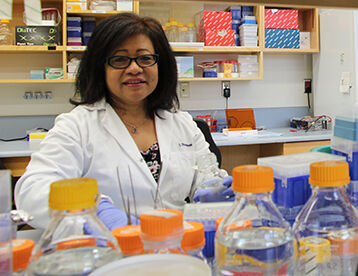Discovery of pinto bean gene means triple win for value chain
Posted on 17 February 2021 by Contributed <p>Dr. Sangeeta Dhaubhadel in her lab.</p>
<p>Dr. Sangeeta Dhaubhadel in her lab.</p>It is a significant breakthrough with both World Pulses Day (Feb. 10) and International Day of Women and Girls in Science (Feb. 11):
Unlike most beans, pinto beans darken with age. This may not sound bad, but if you’re a farmer, a processor or even a consumer, it is.
Darker pinto beans take longer to cook and can also be perceived as less fresh by consumers, which makes them less attractive to buyers. When they’re harder to sell, farmers and vendors end up reducing their price and lose profits. Even processors lose out because longer cooking times mean higher energy costs.
Fortunately, an AAFC researcher and her student have found the solution. After four years of hard work, they found the proverbial “needle in the haystack” — more specifically, the ‘P’ (or ‘pigment’) gene (out of 27,433 genes) which is responsible for this postharvest seed coat darkening.
Can one small gene really affect an entire crop, or does it amount to only a hill of beans? It does matter if we’re talking about pinto beans.
Dr. Sangeeta Dhaubhadel, a scientist at the London Research and Development Centre, explains why:
“Most beans keep the same look after growers harvest and store them. With pinto beans however, the older they are, the darker they become (postharvest seed coat darkening). This is causing serious economic issues for bean farmers and processors. We needed to find the gene responsible.”
— Dr. Sangeeta Dhaubhadel
Older, darker beans take longer to cook (approx. 20 per cent more time) so are less popular with cooks who want convenience. They’re harder to sell, so farmers and vendors reduce their price and lose profit in the process. Longer cooking times also mean higher energy costs for processors.
It was seeing how these problems move through the entire value chain — from farmer to processor to consumer — that spurred Dr. Sangeeta Dhaubhadel to look for a solution. She and her team recently discovered the gene that causes pinto beans to darken with age. Their findings are helping bean breeders create new, slow-darkening varieties more quickly.
There are two types of pinto beans:
•slow-darkening (SD) pinto beans – less popular because they lack some of the desirable agronomic traits (like high yield and adaptability) but their seed coat darkens slowly after harvest
•regular-darkening (RD) pinto beans – more desirable because they give high yields and offer better disease resistance, but their seed coat darkens faster after harvest
While scientists have known the genetic location of the traits for some time, no one had found the specific gene that controls the slow-darkening trait.
In her search, Dr. Dhaubhadel and her team:
•investigated proanthocyanidins (compounds experts thought cause the seed coat darkening). When they compared SD and RD pinto beans, the RD beans had more of this compound
•reviewed research from University of Saskatchewan bean breeders. They found two distinctive areas (known as “markers”) in the pinto bean genome that link to the desirable slow-darkening trait
•and studied the bean genome sequence that scientists published in 2014. This information proved enormously helpful to Dr. Dhaubhadel as she now knew what the gene affecting colour would look like.
All this information helped narrow the search for the gene that affects colour from thousands (27,433 genes to be precise) to just a few.
Next, Dr. Dhaubhadel hired Nishat Islam, a Ph.D. student at Western University, to analyze the genes near the two markers. After eliminating genes that didn’t fit their criteria, only six genes remained. To compare, they looked for genes with similar sequences in other plant species to see if they expressed themselves in seed coat tissue. This comparison showed that only one of the six genes was possibly linked to seed coat colour — the “P” gene.
“P” stands for “pigment”, and scientists have linked this gene to colour in other plant species. During tests, the “P” gene reacted as the research team expected — it changed the colour of the seed coats.
Still curious why RD pinto beans darken faster than SD varieties, Dr. Dhaubhadel’s research further clarified that a single mismatch in the “P” gene sequence between RD and SD pinto beans may be responsible for the higher protein activity in RD than that of the SD “P” gene.
“It took four years to find this gene and solve the puzzle of seed coat darkening. Cloning this gene for testing was very challenging, but when we found the correct gene, we were thrilled. It was a ‘Wow!’ moment.”
— Nishat Islam, Ph.D. student and assistant to Dr. Sangeeta Dhaubhadel
This research helps breeders look at gene sequence earlier which speeds up the whole breeding process. With more than a third of dry bean acres in Canada being dedicated to pinto beans (2019), which are worth millions of dollars, bean breeders can now breathe — and breed — a little easier.
Key Discoveries/Benefits
•Pinto beans darken after growers harvest and store them (postharvest seed coat darkening).
•The darker pinto beans are less popular because they take longer to cook (more inconvenient for consumers) and cost more to process (more expensive for processors). This has caused serious economic losses for bean farmers and processors.
•Agriculture and Agri-Food Canada scientist Dr. Sangeeta Dhaubhadel and her Ph.D. student Nishat Islam discovered the gene that causes pinto beans to darken with age — the “P” gene. This discovery is helping bean breeders create new slow-darkening, faster cooking varieties more quickly.reate new, slow-darkening varieties that cook faster — a recipe that’s bound to please farmers, processors and convenience-loving consumers.
Pinto beans grow in Manitoba, Alberta, Saskatchewan and Ontario and account for more than a third of dry bean acreage in Canada, worth millions of dollars.
Dr. Sangeeta Dhaubhadel in her lab.
Leave a Reply
You must be logged in to post a comment.
